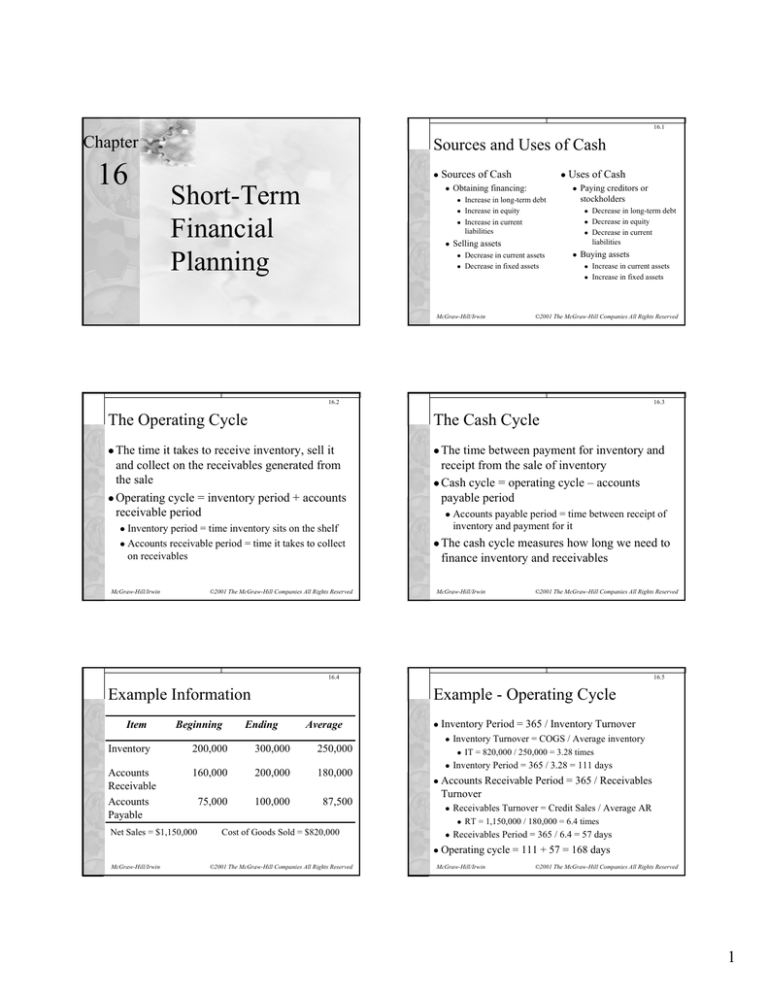
16.0
Chapter
16
16.1
Sources and Uses of Cash
z
Short-Term
Financial
Planning
McGraw-Hill/Irwin
Sources of Cash
z
z
z
z
z
z
Obtaining financing:
Uses of Cash
z
Increase in long-term debt
Increase in equity
Increase in current
liabilities
Paying creditors or
stockholders
z
z
z
Selling assets
z
z
Decrease in current assets
Decrease in fixed assets
z
Buying assets
z
z
©2001 The McGraw-Hill Companies All Rights Reserved
McGraw-Hill/Irwin
Decrease in long-term debt
Decrease in equity
Decrease in current
liabilities
Increase in current assets
Increase in fixed assets
©2001 The McGraw-Hill Companies All Rights Reserved
16.2
16.3
The Operating Cycle
The Cash Cycle
z The
z The
time it takes to receive inventory, sell it
and collect on the receivables generated from
the sale
z Operating cycle = inventory period + accounts
receivable period
Inventory period = time inventory sits on the shelf
z Accounts receivable period = time it takes to collect
on receivables
time between payment for inventory and
receipt from the sale of inventory
z Cash cycle = operating cycle – accounts
payable period
z
z
McGraw-Hill/Irwin
©2001 The McGraw-Hill Companies All Rights Reserved
Accounts payable period = time between receipt of
inventory and payment for it
z The
cash cycle measures how long we need to
finance inventory and receivables
McGraw-Hill/Irwin
©2001 The McGraw-Hill Companies All Rights Reserved
16.4
Example Information
Item
Inventory
Accounts
Receivable
Accounts
Payable
Beginning
200,000
Example - Operating Cycle
Ending
300,000
Average
z
250,000
160,000
200,000
180,000
75,000
100,000
87,500
Net Sales = $1,150,000
16.5
z
Inventory Turnover = COGS / Average inventory
z
Inventory Period = 365 / 3.28 = 111 days
z
z
©2001 The McGraw-Hill Companies All Rights Reserved
IT = 820,000 / 250,000 = 3.28 times
Accounts Receivable Period = 365 / Receivables
Turnover
z
Receivables Turnover = Credit Sales / Average AR
z
Receivables Period = 365 / 6.4 = 57 days
z
Cost of Goods Sold = $820,000
z
McGraw-Hill/Irwin
Inventory Period = 365 / Inventory Turnover
RT = 1,150,000 / 180,000 = 6.4 times
Operating cycle = 111 + 57 = 168 days
McGraw-Hill/Irwin
©2001 The McGraw-Hill Companies All Rights Reserved
1
16.6
16.7
Example - Cash Cycle
Short-Term Financial Policy
z Accounts
z
Payables Period = 365 / payables
turnover
z
z
Payables turnover = COGS / Average AP
z
Accounts payables period = 365 / 9.4 = 39 days
z
PT = 820,000 / 87,500 = 9.4 times
z
z Cash
cycle = 168 – 39 = 129 days
z So, we have to finance our inventory and
receivables for 129 days
z
z
z
McGraw-Hill/Irwin
Flexible (Conservative)
Policy
©2001 The McGraw-Hill Companies All Rights Reserved
Large amounts of cash and
marketable securities
Large amounts of
inventory
Liberal credit policies
(large accounts receivable)
Relatively low levels of
short-term liabilities
High liquidity
McGraw-Hill/Irwin
z
Restrictive (Aggressive)
Policy
z
z
z
z
z
Low cash and marketable
security balances
Low inventory levels
Little or no credit sales
(low accounts receivable)
Relatively high levels of
short-term liabilities
Low liquidity
©2001 The McGraw-Hill Companies All Rights Reserved
16.8
16.9
Carrying versus Shortage Costs
Temporary versus Permanent Assets
z Carrying
z Are
costs
Opportunity cost of owning current assets versus
long-term assets that pay higher returns
z Cost of storing larger amounts of inventory
z
z Shortage
costs
Order costs – the cost of ordering additional
inventory or transferring cash
z Stock-out costs – the cost of lost sales due to lack of
inventory, including lost customers
z
McGraw-Hill/Irwin
©2001 The McGraw-Hill Companies All Rights Reserved
z
current assets temporary or permanent?
Both!
z Permanent
current assets refer to the level of
current assets that the company retains
regardless of any seasonality in sales
z Temporary current assets refer to the additional
current assets that are added when sales are
expected to increase on a seasonal basis
McGraw-Hill/Irwin
©2001 The McGraw-Hill Companies All Rights Reserved
16.10
Figure 16.4
Policy F
Dollars
Choosing the Best Policy
z Best
Policy R
Total asset
requirement
Marketable
securities
16.11
Dollars
Long-term
financing
Short-term
financing
Total asset
requirement
Long-term
financing
policy will be a combination of flexible
and restrictive policies
z Things to consider
Cash reserves
Maturity hedging
z Relative interest rates
z
z
Time
Policy F always implies a short-term
cash surplus and a large investment
in cash and marketable securities.
McGraw-Hill/Irwin
Time
Policy R uses long-term financing for
permanent asset requirements only and
short-term borrowing for seasonal
variations.
©2001 The McGraw-Hill Companies All Rights Reserved
z Compromise
policy – borrow short-term to
meet peak needs, maintain a cash reserve for
emergencies
McGraw-Hill/Irwin
©2001 The McGraw-Hill Companies All Rights Reserved
2
16.12
Figure 16.5
16.13
Cash Budget
z Primary
Dollars
Total seasonal
variation
Short-term
financing
Flexible policy (F)
Compromise policy (C)
Restrictive policy (R)
z How
Marketable
securities
it works
Identify sales and cash collections
z Identify various cash outflows
z Subtract outflows from inflows and determine
investing and financing needs
z
General growth in
fixed assets
and permanent
current assets
Time
With a compromise policy, the firm keeps a reserve of liquidity that it uses
to initially finance seasonal variations in current asset needs. Short-term
borrowing is used when the reserve is exhausted.
McGraw-Hill/Irwin
tool in short-run financial planning
Identify short-term needs and potential opportunities
z Identify when short-term financing may be required
z
©2001 The McGraw-Hill Companies All Rights Reserved
McGraw-Hill/Irwin
©2001 The McGraw-Hill Companies All Rights Reserved
16.14
Short-Term Borrowing
z
z
z
z
z
Example: Factoring
Unsecured loans
z
16.15
Selling receivables to someone else at a discount
Example: You have an average of $1 million in
receivables and you borrow money by factoring
receivables with a discount of 2.5%. The receivables
turnover is 12 times per year.
z What is the APR?
z
Line of credit – prearranged agreement with a bank that allows the
firm to borrow up to a certain amount on a short-term basis
Committed – formal legal arrangement that may require a
commitment fee and generally has a floating interest rate
Non-committed – informal agreement with a bank that is similar to
credit card debt for individuals
Revolving credit – non-committed agreement with a longer time
between evaluations
Secured loans – loan secured by receivables or inventory or
both
z
z
z
z
What is the effective rate?
z
McGraw-Hill/Irwin
©2001 The McGraw-Hill Companies All Rights Reserved
Period rate = .025/.975 = 2.564%
APR = 12(2.564%) = 30.769%
EAR = 1.0256412 – 1 = 35.502%
McGraw-Hill/Irwin
©2001 The McGraw-Hill Companies All Rights Reserved
16.16
Chapter 16 Quick Quiz
What is the operating cycle and the cash cycle?
What are the differences between flexible and
restrictive short-term financial policies?
z What factors do we need to consider when choosing a
financial policy?
z What factors go into determining a cash budget and
why is it valuable?
z
McGraw-Hill/Irwin
©2001 The McGraw-Hill Companies All Rights Reserved
3





